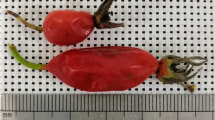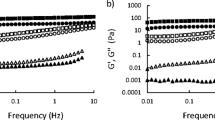Abstract
The rheological property of Shanxi aged vinegar (SAV) was determined by rheometer, and its effects on release in eight key aroma components of SAV was investigated by SPME–GC–MS. In order to simulate the change of rheological property of SAV, a modified SAV system was developed from a finished SAV using carboxymethylcellulose, pectin, glucose, fructose, sodium chloride and tannic acid at indicate levels. The consistency coefficients (K) of SAV ranged from 1.09e−5 to 0.0137, which was correlated to glucose, polyphenol, acids and oBx. SAV changed from shear-thickening to Newtonian fluid during long-time ageing. In the modified SAV system, the K values increased significantly, and two modified vinegar became quasi-Newtonian fluids too. Furthermore, release of the eight key aroma compounds decreased significantly and decreased was pronounced, for acetic acid, furfural and tetramethylpyrazine. The results demonstrated rheological property correlated to the concentrate of sugar, salt, polyphenol, acids and macromolecule, which significantly affected the release of major aroma compounds.

Similar content being viewed by others
References
AOAC (1990) Official methods of analysis. AOAC International, Washington
Arancibia C, Jublot L, Costell E, Bayarri S (2011) Flavor release and sensory characteristics of o/w emulsions. Influence of composition, microstructure and rheological behavior. Food Res Int 44:1632–1641. doi:10.1016/j.foodres.2011.04.049
Bayarri S, Smith T, Hollowood T, Hort J (2007) The role of rheological behaviour in flavour perception in model oil/water emulsions. Eur Food Res Technol 226:161–168
Bourne M (2002) Food texture and viscosity: concept and measurement. Academic, Cambridge
Budak HN, Guzel-Seydim ZB (2010) Antioxidant activity and phenolic content of wine vinegars produced by two different techniques. J Sci Food Agric 90:2021–2026
Chen T, Gui Q, Shi JJ, Zhang XY, Chen FS (2013) Analysis of variation of main components during aging process of Shanxi aged vinegar. Acetic Acid Bact 2:6
Christensen CM (1980) Effects of taste quality and intensity on oral perception of viscosity. Percept Psychophys 28:315–320
Crank J (1979) The mathematics of diffusion. Oxford University Press, Oxford
Decourcelle N, Lubbers S, Vallet N, Rondeau P, Guichard E (2004) Effect of thickeners and sweeteners on the release of blended aroma compounds in fat-free stirred yoghurt during shear conditions. Int Dairy J 14:783–789
Falcone PM, Giudici P (2008) Molecular size and molecular size distribution affecting traditional balsamic vinegar aging. J Agric Food Chem 56:7057–7066. doi:10.1021/jf800706g
Falcone PM, Chillo S, Giudici P, Del Nobile MA (2007) Measuring rheological properties for applications in quality assessment of traditional balsamic vinegar: description and preliminary evaluation of a model. J Food Eng 80:234–240. doi:10.1016/j.jfoodeng.2006.05.023
Falcone PM, Verzelloni E, Tagliazucchi D, Giudici P (2008) A rheological approach to the quantitative assessment of traditional balsamic vinegar quality. J Food Eng 86:433–443
Falcone PM, Mozzon M, Frega NG (2012) Structure–composition relationships of the traditional balsamic vinegar of Modena close to jamming transition (part II): threshold control parameters. Food Res Int 45:75–84
Fan J, Zhang Y, Zhou L, Li Z, Zhang B, Saito M, Wang X (2011) Nutritional composition and. ALPHA.-glucosidase inhibitory activity of five Chinese vinegars. Jpn Agric Res Q JARQ 45:445–456
Godshall MA (1997) How carbohydrates influence food flavor. Food Technol 51:63–67
Liu D, Zhu Y, Beeftink R, Ooijkaas L, Rinzema A, Chen J, Tramper J (2004) Chinese vinegar and its solid-state fermentation process. Food Rev Int 20:407–424
Lubbers S, Butler E (2010) Effects of texture and temperature on the kinetic of aroma release from model dairy custards. Food Chem 123:345–350. doi:10.1016/j.foodchem.2010.04.041
Lubbers S, Decourcelle N, Vallet N, Guichard E (2004) Flavor release and rheology behavior of strawberry fatfree stirred yogurt during storage. J Agric Food Chem 52:3077–3082
Masino F, Chinnici F, Bendini A, Montevecchi G, Antonelli A (2008) A study on relationships among chemical, physical, and qualitative assessment in traditional balsamic vinegar. Food Chem 106:90–95
Mitropoulou A, Hatzidimitriou E, Paraskevopoulou A (2011) Aroma release of a model wine solution as influenced by the presence of non-volatile components. Effect of commercial tannin extracts, polysaccharides and artificial saliva. Food Res Int 44:1561–1570. doi:10.1016/j.foodres.2011.04.023
Muñoz-González C, Martín-Álvarez PJ, Moreno-Arribas MV, Pozo-Bayón MÁ (2014) Impact of the nonvolatile wine matrix composition on the in vivo aroma release from wines. J Agric Food Chem 62:66–73. doi:10.1021/jf405550y
Paula Barros E, Moreira N, Elias Pereira G, Leite SGF, Moraes Rezende C, Guedes de Pinho P (2012) Development and validation of automatic HS-SPME with a gas chromatography-ion trap/mass spectrometry method for analysis of volatiles in wines. Talanta 101:177–186. doi:10.1016/j.talanta.2012.08.028
Poinot P, Arvisenet G, Ledauphin J, Gaillard J-L, Prost C (2013) How can aroma–related cross–modal interactions be analysed? A review of current methodologies. Food Qual Prefer 28:304–316. doi:10.1016/j.foodqual.2012.10.007
Quek MC, Chin NL, Yusof YA (2013) Modelling of rheological behaviour of soursop juice concentrates using shear rate–temperature–concentration superposition. J Food Eng 118:380–386
Roberts DD, Elmore JS, Langley KR, Bakker J (1996) Effects of sucrose, guar gum, and carboxymethylcellulose on the release of volatile flavor compounds under dynamic conditions. J Agric Food Chem 44:1321–1326. doi:10.1021/jf950567c
Tabilo-Munizaga G, Barbosa-Cánovas GV (2005) Rheology for the food industry. J Food Eng 67:147–156. doi:10.1016/j.jfoodeng.2004.05.062
Wang A, Song H, Ren C, Li Z (2012a) Key aroma compounds in Shanxi aged tartary buckwheat vinegar and changes during its thermal processing. Flavour Fragr J 27:47–53
Wang A, Zhang J, Li Z (2012b) Correlation of volatile and nonvolatile components with the total antioxidant capacity of tartary buckwheat vinegar: influence of the thermal processing. Food Res Int 49:65–71
Wilke CR, Chang P (1955) Correlation of diffusion coefficients in dilute solutions. AIChE J 1:264–270. doi:10.1002/aic.690010222
Xiao Z, Dai S, Niu Y, Yu H, Zhu J, Tian H, Gu Y (2011) Discrimination of Chinese vinegars based on headspace solid-phase microextraction-gas chromatography mass spectrometry of volatile compounds and multivariate analysis. J Food Sci 76:C1125–C1135
Zhu H, Zhu J, Wang L, Li Z (2016) Development of a SPME-GC-MS method for the determination of volatile compounds in Shanxi aged vinegar and its analytical characterization by aroma wheel. J Food Sci Technol 53:171–183
Acknowledgments
This research was funded by the Chinese Agricultural Research System (grant number: CARS-08-D-3).
Author information
Authors and Affiliations
Corresponding author
Ethics declarations
Conflict of interest
There is no conflict of interest to be declared.
Rights and permissions
About this article
Cite this article
Zhu, H., Qiu, J. & Li, Z. Determination of rheological property and its effect on key aroma release of Shanxi aged vinegar. J Food Sci Technol 53, 3304–3311 (2016). https://doi.org/10.1007/s13197-016-2305-x
Revised:
Accepted:
Published:
Issue Date:
DOI: https://doi.org/10.1007/s13197-016-2305-x




